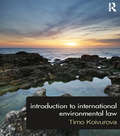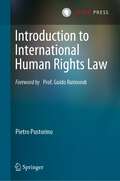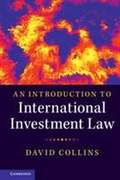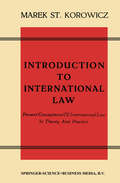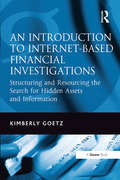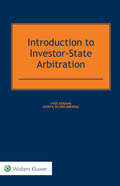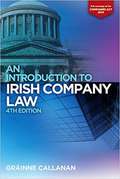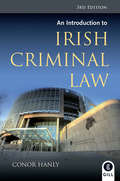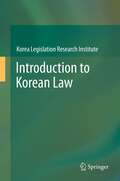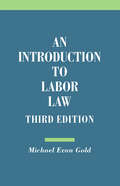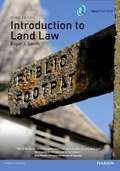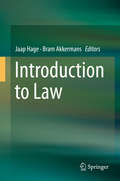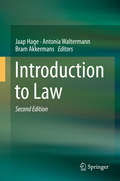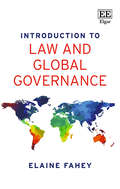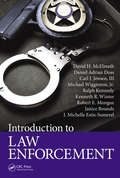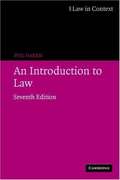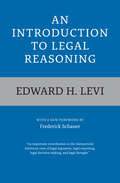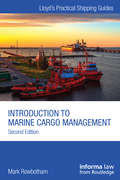- Table View
- List View
Introduction to International Environmental Law
by Timo KoivurovaIntroduction to International Environmental Law provides a concise overview of international environmental law and the relations and agreements among nations to facilitate environmental protection. Beginning by exploring the history nature and sources of international environmental law, Professor Koivurova moves on to consider the key principles as well as examining the implementation and effectiveness of international environmental law in practice. It considers how international environmental law has developed away from other branches of international law which are heavily based on state sovereignty, in order to more effectively facilitate environmental protection and concludes by posing questions about the future of the field. Taking a concise, accessible approach throughout and employing case studies drawn from a global range of examples, this book is the ideal first point of entry to the context, principles and issues of this important subject.
Introduction to International Human Rights Law
by Pietro PustorinoThis book offers a compact but general introduction to international human rights law. It discusses the theoretical, historical and legal foundations of international human rights law, providing an encompassing analysis of the substantive content of the most important human rights and of the role of States and non-State actors in ensuring their respect. It also carries out a specific analysis of the UN system and the ECHR and other regional systems – all this while constantly situating the discussion on international human rights law within the broader framework of public international law. While particularly suitable for undergraduate students in law, this book is also aimed at students of political science and other social sciences, as well as academics and practitioners.Pietro Pustorino is Full Professor of International Law at the Department of Law of Luiss University (Rome, Italy) and Director of the Luiss Center for International and Strategic Studies.
An Introduction to International Investment Law (PDF)
by David CollinsThis insightful and accessible introduction provides students and practitioners with a comprehensive overview of the increasingly important discipline of international investment law. Focusing primarily on the legal principles contained in the growing body of international investment agreements, this book covers the core concepts of the discipline, with attention given to their relation to each other and to the manner in which they have been developed through arbitration case law. The context of each legal principle is explored, along with a consideration of some of the major debates and emerging criticisms. Avoiding extensive case extracts, this book adopts an engaging and succinct narrative style which allows readers to advance their understanding of the topic while examining the legal principles with academic rigour and discerning commentary.
Introduction to International Law: Present Conceptions Of International Law In Theory And Practice
by Marek St. KorowiczThis book in its entirety as well as in each of its parts is an outline of the problems under discussion. The subject matter of some eighty sections of the book is extensive; it could, indeed, be presented by ex perts in as many volumes. This study offers an attempt to formulate a synthesis, however difficult, of the vast amount of available material. Unlike the well-known standard Introductions to International Law which deal with all the major fields of international law, this book treats exclusively the present conceptions of that law as expressed in legal literature, international treaties and other agreements, inter national judgements and awards, governmental and diplomatic state ments and the like. Special attention is devoted, in several chapters of the book, to the "teachings of the most highly qualified publicists of the various nations" which are considered by Article 38 paragraph 1 (d) of the Statute of the International Court of Justice as "subsidiary means for the determination ofrules of law. " An endeavor is made to ascertain whether in certain fields of the theory of international law a "Communis opinio doctorum" has either been reached or is in the process of achievement. Some readers may consider that there are too many quotations from writings of publicists; others will certainly feel - as does this writer - that too many outstanding international lawyers have not been included.
An Introduction to Internet-Based Financial Investigations: Structuring and Resourcing the Search for Hidden Assets and Information
by Kimberly GoetzIncreasingly, employees of regulatory bodies, law enforcement agencies and others who are not trained forensic accountants or experienced investigators find themselves responsible for conducting what amount to financial investigations. An engineer who oversees the cleanup of a toxic waste site might need to track down the former owners of the site to find the polluter. Perhaps the applicable licensing agency receives a complaint that an attorney mishandled a client's money. Maybe it's the attorney who needs help finding the assets with which a client's former spouse has absconded. Training in investigation techniques tends to be very limited for many employees. Training on how to find information without incurring significant expense is virtually nonexistent. This book helps fill the void. An Introduction to Internet-Based Financial Investigations will help anyone who conducts financial investigations as part of their job to reduce their dependence on trial and error by showing them where and how to look. Using clear sections describing how to approach an investigation, including the ethical perspective; what to look for and what you find; what free and low cost internet resources are available to support investigations; and how to assemble and present the results of investigations, Kimberly Goetz guides students and beginning investigators through the complex world of financial investigations.
An Introduction to Internet-Based Financial Investigations: Structuring and Resourcing the Search for Hidden Assets and Information
by Kimberly GoetzIncreasingly, employees of regulatory bodies, law enforcement agencies and others who are not trained forensic accountants or experienced investigators find themselves responsible for conducting what amount to financial investigations. An engineer who oversees the cleanup of a toxic waste site might need to track down the former owners of the site to find the polluter. Perhaps the applicable licensing agency receives a complaint that an attorney mishandled a client's money. Maybe it's the attorney who needs help finding the assets with which a client's former spouse has absconded. Training in investigation techniques tends to be very limited for many employees. Training on how to find information without incurring significant expense is virtually nonexistent. This book helps fill the void. An Introduction to Internet-Based Financial Investigations will help anyone who conducts financial investigations as part of their job to reduce their dependence on trial and error by showing them where and how to look. Using clear sections describing how to approach an investigation, including the ethical perspective; what to look for and what you find; what free and low cost internet resources are available to support investigations; and how to assemble and present the results of investigations, Kimberly Goetz guides students and beginning investigators through the complex world of financial investigations.
Introduction to Investor-State Arbitration
by Yves Derains Josefa Sicard-MirabalToday thousands of investors act globally in markets providing services, technology or capital in countries all around the world. This activity can be peacefully accomplished when both the investor and the host State know that the disputes will be resolved under the aegis of the investor-State arbitration regime, wherein an investor is provided with a direct right of action against a State, most commonly stemming from a bilateral or multilateral investment treaty. This book approaches the substantive and sometimes difficult concepts of investor-State arbitration in a clear and concise explanatory fashion. In the course of acquainting the reader with the basic legal concepts and policies of the regime, the authors address such issues as the following: • consent to jurisdiction; • State responsibility; • possible conflict of interests; • mechanisms for reviewing an award; • damages and costs; and • enforcement. The book examines a number of arbitration procedures arising from various perspectives with differing underlying assumptions while highlighting important cases. Given that investor-State arbitration is now under the public watch and facing many challenges, this remarkably clear and concise overview of the regime will prove to be of great value to in-house counsel and other practitioners, as well as to government policymakers and students.x`
An Introduction to Irish Company Law (Fourth Edition) (PDF)
by Gráinne CallananFourth edition of this popular introductory textbook for students, which is fully revised and updated to reflect the new landscape of company law following the introduction of the COMPANIES ACT 2014. NEW TO THIS EDITION: Restructured and rewritten to reflect the format and content of the Companies Act 2014, with particular focus on the new model private company limited by shares and the key changes in relation to the following: New types of companies Transition arrangements New form constitution for private companies limited by shares New optional statutory default provisions to replace Table A New capital maintenance rules Codification of directors' fiduciary duties Additional statutory duties for directors New decision making procedures for members Provisions for revising financial statements New summary approval procedure for restricted activities All key cases since the last edition Increased emphasis on standard company law modules on undergraduate Law, Business and Accountancy Programmes Covers the core areas of company law in Ireland Designed to help students understand the principles of Company Law Written in a clear and concise style SUITABLE FOR Students of company law in undergraduate law and business programmes at universities, institutes of technology and other third-level Institutions Those taking professional accountancy examinations THE AUTHOR Grainne Callanan, BCL, LLM, MBS, Cdip (A&F) has been a lecturer in company and insolvency Law at Waterford Institute of Technology for over 20 years. She has a number of publications in the field of company law. She was previously employed in the corporate banking sector.
An Introduction To Irish Criminal Law (PDF)
by Conor HanlyFully revised and updated edition, with a greater focus on standard university criminal law syllabi. All major changes to criminal law up to the end of 2013 are discussed, including: New Legislation Covered in Detail Criminal Law (Sexual Offences) Act 2006 Criminal Law (Insanity) Act 2006 Criminal Law (Sexual Offences) (Amendment) Act 2007 Criminal Law (Insanity) Act 2010 Criminal Law (Defence and the Dwelling) Act 2011 Criminal Justice (Public Order) Act 2011 Protection of Life During Pregnancy Act 2013 New Legislation, individual provisions of which will be covered Criminal Justice Act 2006 Criminal Justice Act 2007 Criminal Justice (Human Trafficking) Act 2008 Criminal Justice (Amendment) Act 2009 Criminal Procedure Act 2010 Criminal Justice Act 2011 Criminal Justice (Female Genital Mutilation) Act 2012 Criminal Justice (Withholding of Information on Offences against Children and Vulnerable Adults) Act 2012 Criminal Law (Human Trafficking) (Amendment) Act 2013 Law Reform Commission Papers Report on Homicide: Murder and Involuntary Manslaughter (LRC 87-2008) Report on Defences in Criminal Law (LRC 95-2009) Report on Inchoate Offences (LRC 99-2010) Consultation Paper on Sexual Offences and Capacity to Consent (LRC CP 63-2011) Written For: Law students Legal professional entry exams Social care and social science courses
Introduction to Korean Law
by Korea Legislation Research InstituteAs a result of globalization, the barriers between countries are coming down. There is more interaction between countries than ever and mutual understanding and communication have become essential considerations. In such an atmosphere, the Korea Legislation Research Institute has published this book to spread awareness of outstanding Korean law and of its legal system throughout the globe, as the authoritative sources of legal information for other countries. This book explains Korean law in nine chapters that focus on its distinguishing aspects. The nine authors who have participated are all prominent scholars who have contributed their expertise to the project.
An Introduction to Labor Law
by Michael Evan GoldAn Introduction to Labor Law is a useful primer that explains the basic principles of the federal law regulating the relationship of employers to labor unions. In this updated third edition, which features a new introduction, Michael Evan Gold discusses the law that applies to union organizing and representation elections, the duty to bargain in good faith, economic weapons such as strikes and lockouts, and the enforcement of collective bargaining agreements. Gold describes the structure and functions of the National Labor Relations Board and of the federal courts in regard to labor cases and also presents a number of legal issues presently in contention between labor and management.
An Introduction to Land Law
by Simon Gardner Emily MacKenzieGardner and MacKenzie's An Introduction to Land Law has been widely acclaimed by students and teachers for the distinctively informative and stimulating way in which it addresses this challenging subject.Concise and highly readable, it covers the main points of land law found in the syllabuses of law schools in England and Wales. While not intended as a comprehensive textbook, it provides both sufficient detail, and especially the illuminating overview needed, for a real understanding, and many pointers for those seeking more.Most of all, it stands apart from other land law books in the model it offers of critical engagement with the material. As the authors say in their Preface:[W]e aim not just to state the law, but to paint its portrait, or tell its story, or something of that kind. So we set out to offer a careful, thoughtful, honest and critical (but not unsympathetic) appraisal, from a number of directions, both doctrinal and contextual. Once again, too, we present the portrait or story partly for its own interest, but most of all so as to encourage readers to try something similar for themselves – to reflect on the subject more, and so understand it better, and at the same time deepen their thinking skills in general.As well as updating the book's overall coverage, this new edition features reworked discussions of areas where the law has recently undergone substantial change, and also where the authors' thoughts themselves have developed – including ownership, easements, and rectification of the land register.As one reader of the first edition commented, 'it shone light where none had shone before, and lit a clear path to understanding'.
An Introduction to Land Law
by Simon Gardner Emily MacKenzieThe rules of land law are numerous, complex, and in some cases baffling to students. The study of land law is also often portrayed as dull. Too frequently those who find success in working out how the law operates in other areas find themselves defeated by land law. Even the great jurist Blackstone, while maintaining that 'there is nothing which so generally strikes the imagination, and engages the affections of mankind, as the right of property', also concluded that the study of land law 'afforded the student less amusement and pleasure in the pursuit' than the study of crime and tort.This book tries to help with that problem. It aims to tell the rules' story: to talk about them in terms of the work they do, in a way that will allow readers to understand and engage with them. And through the example it offers, it aims also to give students the confidence, spur and tools to go on to develop such perspectives for themselves. The book covers the main points of land law found in the syllabuses of law schools in England and Wales. While it is not intended as a comprehensive textbook on the topic, it offers sufficient detail for anyone reading it to gain an overview of the subject, and for those seeking more the footnotes offer plenty of pointers. As well as bringing the coverage up to date, this new edition adds chapters about two especially challenging aspects of the subject: the human rights dimension, and the nature of 'ownership'. As one reader of the first edition commented, 'it shone light where none had shone before, and lit a clear path to understanding'. 'Well written and clear. A great introduction.'Mika Oldham, Jesus College, Cambridge 'An excellent introduction. Many students will no doubt buy it.'Matthew Conaglen, Trinity Hall, Cambridge 'A very clear and interesting way into a complex subject.'David Gregory, Kingston University
Introduction To Land Law 3e (PDF)
by Roger SmithA comprehensive and concise introduction to land law, demonstrating great strength in clarity of the text without compromising coverage. The online support resources are particularly welcome. Dr Lucy Barnes, University of East Anglia One of the few books in this area which lives up to its title. It really does give the student an introduction to the subject. Dave Powell, formerly University of Teesside A clear, concise and accurate introductory text written by a leading authority in land law. Professor Antonia Layard, University of Birmingham The text is clear and easy to understand. It explains the issues very well indeed without over-simplifying fundamental points. Professor Janine Griffiths-Baker, St Mary's University College Roger Smith's Introduction to Land Law presents a straightforward account of the law and its effects, providing clear explanations of legal concepts students often find difficult to grasp and illuminating the interesting and thought-provoking issues stemming from land law. The third edition incorporates leading decisions from the Supreme Court which have lately emerged in important areas of land law such as human rights (Manchester CC v Pinnock), leases (Jones v Kernott) and the family home (Mexfield Housing Co-operative Ltd v Berrisford). The chapter on the family home has been substantially revised to reflect recent developments.
Introduction to Law
by Jaap Hage Bram AkkermansThis book is exceptional in the sense that it provides an introduction to law in general rather than the law of one specific jurisdiction, and it presents a unique way of looking at legal education. It is crucial for lawyers to be aware of the different ways in which societal problems can be solved and to be able to discuss the advantages and disadvantages of different legal solutions. In this respect, being a lawyer involves being able to reason like a lawyer, even more than having detailed knowledge of particular sets of rules. Introduction to Law reflects this view by focusing on the functions of rules and on ways of arguing the relative qualities of alternative legal solutions. Where ‘positive’ law is discussed, the emphasis is on the legal questions that must be addressed by a field of law and on the different solutions which have been adopted by, for instance, the common law and civil law tradition. The law of specific jurisdictions is discussed to illustrate possible answers to questions such as when the existence of a valid contract is assumed.
Introduction to Law
by Jaap Hage Antonia Waltermann Bram AkkermansThis book is exceptional in the sense that it provides an introduction to law in general rather than the law of one specific jurisdiction, and it presents a unique way of looking at legal education. It is crucial for lawyers to be aware of the different ways in which societal problems can be solved and to be able to discuss the advantages and disadvantages of different legal solutions. In this respect, being a lawyer involves being able to reason like a lawyer, even more than having detailed knowledge of particular sets of rules. Introduction to Law reflects this view by focusing on the functions of rules and on ways of arguing the relative qualities of alternative legal solutions. Where ‘positive’ law is discussed, the emphasis is on the legal questions that must be addressed by a field of law and on the different solutions which have been adopted by, for instance, the common law and civil law tradition. The law of specific jurisdictions is discussed to illustrate possible answers to questions such as when the existence of a valid contract is assumed.
Introduction to Law and Global Governance
by Elaine FaheyThis innovative textbook introduces the idea of law existing, operating, and functioning beyond the Nation State. Offering a structured approach, Elaine Fahey breaks down the core aspects of theory, practice and regulation in order to examine the key conceptual and factual components of the relationship between law and global governance. An excellent teaching resource for both undergraduate and postgraduate levels, the key features of this textbook include: • An interdisciplinary approach to the understanding of the interaction of law and globalisation to provide readers with snapshots of key thematic issues • Four substantive chapters on global governance, actors, sovereignty, and borders and territory to help the reader engage with a diversity of themes and topics, united under broader concepts which are at the heart of understanding what is beyond the Nation State • Two further chapters on trade and data to immerse the reader further into areas of law beyond the State which are important in contemporary times • Highlighted boxes to help identify key information, whilst further reflection points and suggested further reading at the end of each chapter offer context to the topics discussed. With its broad theoretical reach, this textbook will be an invaluable teaching and learning tool for students of law, international relations, politics, political science, governance, and transnational law and governance.
Introduction to Law Enforcement
by David H. McElreathModern perspectives of law enforcement are both complex and diverse. They integrate management and statistical analysis functions, public and business administration functions, and applications of psychology, natural science, physical fitness, and marksmanship. They also assimilate theories of education, organizational behavior, economics, law and
Introduction to Law Enforcement
by David H. McElreath Daniel Adrian Doss Carl J. Jensen III Michael Wigginton Jr. Ralph Kennedy Kenneth R. Winter Robert E. Mongue Janice Bounds J. Michelle Estis-SumerelModern perspectives of law enforcement are both complex and diverse. They integrate management and statistical analysis functions, public and business administration functions, and applications of psychology, natural science, physical fitness, and marksmanship. They also assimilate theories of education, organizational behavior, economics, law and
An Introduction to Law (Seventh Edition) (PDF)
by Phil HarrisSince the publication of its first edition, this textbook has become the definitive student introduction to the subject. As with earlier editions, the seventh edition gives a clear understanding of fundamental legal concepts and their importance within society. In addition, this book addresses the ways in which rules and the structures of law respond to and impact upon changes in economic and political life. The title has been extensively updated and explores recent high profile developments such as the Civil Partnership Act 2005 and the Racial and Religious Hatred Bill. This introductory text covers a wide range of topics in a clear, sensible fashion giving full context to each. For this reason, An Introduction to Law is ideal for all students of law, be they undergraduate law students, those studying law as part of a mixed degree, or students on social sciences courses which offer law options.
An Introduction to Legal Reasoning
by Edward H. LeviOriginally published in 1949, An Introduction to Legal Reasoning is widely acknowledged as a classic text. As its opening sentence states, “This is an attempt to describe generally the process of legal reasoning in the field of case law and in the interpretation of statutes and of the Constitution.” In elegant and lucid prose, Edward H. Levi does just that in a concise manner, providing an intellectual foundation for generations of students as well as general readers. For this edition, the book includes a substantial new foreword by leading contemporary legal scholar Frederick Schauer that helpfully places this foundational book into its historical and legal contexts, explaining its continuing value and relevance to understanding the role of analogical reasoning in the law. This volume will continue to be of great value to students of logic, ethics, and political philosophy, as well as to members of the legal profession and everyone concerned with problems of government and jurisprudence.
An Introduction to Legal Reasoning
by Edward H. LeviOriginally published in 1949, An Introduction to Legal Reasoning is widely acknowledged as a classic text. As its opening sentence states, “This is an attempt to describe generally the process of legal reasoning in the field of case law and in the interpretation of statutes and of the Constitution.” In elegant and lucid prose, Edward H. Levi does just that in a concise manner, providing an intellectual foundation for generations of students as well as general readers. For this edition, the book includes a substantial new foreword by leading contemporary legal scholar Frederick Schauer that helpfully places this foundational book into its historical and legal contexts, explaining its continuing value and relevance to understanding the role of analogical reasoning in the law. This volume will continue to be of great value to students of logic, ethics, and political philosophy, as well as to members of the legal profession and everyone concerned with problems of government and jurisprudence.
An Introduction to Legal Reasoning
by Edward H. LeviOriginally published in 1949, An Introduction to Legal Reasoning is widely acknowledged as a classic text. As its opening sentence states, “This is an attempt to describe generally the process of legal reasoning in the field of case law and in the interpretation of statutes and of the Constitution.” In elegant and lucid prose, Edward H. Levi does just that in a concise manner, providing an intellectual foundation for generations of students as well as general readers. For this edition, the book includes a substantial new foreword by leading contemporary legal scholar Frederick Schauer that helpfully places this foundational book into its historical and legal contexts, explaining its continuing value and relevance to understanding the role of analogical reasoning in the law. This volume will continue to be of great value to students of logic, ethics, and political philosophy, as well as to members of the legal profession and everyone concerned with problems of government and jurisprudence.
An Introduction to Legal Reasoning
by Edward H. LeviOriginally published in 1949, An Introduction to Legal Reasoning is widely acknowledged as a classic text. As its opening sentence states, “This is an attempt to describe generally the process of legal reasoning in the field of case law and in the interpretation of statutes and of the Constitution.” In elegant and lucid prose, Edward H. Levi does just that in a concise manner, providing an intellectual foundation for generations of students as well as general readers. For this edition, the book includes a substantial new foreword by leading contemporary legal scholar Frederick Schauer that helpfully places this foundational book into its historical and legal contexts, explaining its continuing value and relevance to understanding the role of analogical reasoning in the law. This volume will continue to be of great value to students of logic, ethics, and political philosophy, as well as to members of the legal profession and everyone concerned with problems of government and jurisprudence.
Introduction to Marine Cargo Management (Lloyd's Practical Shipping Guides)
by Mark RowbothamCargo management, especially in the maritime sphere, plays a vital role in the transfer of goods between seller and buyer. However, despite over 90% of the world’s international trade being conducted by sea, often very little is known about this subject by either party. This unique text provides a clear and comprehensive introduction to the principal elements involved in the management of marine cargo and the carriage of goods by sea. Not only does it analyse key theories and debates in the maritime freight sector, it is equally instructive on practice and logistics. Furthermore, the book provides a thorough guide to the roles and responsibilities of all parties involved in this dynamic industry. This second edition has been fully revised and updated to incorporate the very latest changes in cargo management legislation and procedures, including: Offshore oil & gas supply management The revised INCOTERMS 2010 Tramp shipping and spot cargo trading Project cargo management Dry and liquid bulk cargo management The IMDG Code and the marine carriage of dangerous and hazardous goods Cabotage Salvage Risk management and best practice This is an essential guide for shipping professionals, academics and students of marine logistics, and international trade.
